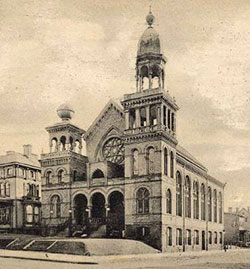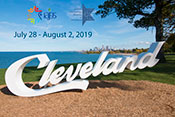Barnert Temple -
Congregation B'nai Jeshurun

B'nai Jeshurun was a traditional Ashkenazi Orthodox congregation formed in 1847 by German Jewish merchants and professional men, joined by some Jews from Bialystok, Poland, eastern Europe's textile center. By 1858 the small congregation rented space in a building on West Street and moved in 1860 to new quarters at 9 Mulberry Street. Because the congregation at this time was still small, it often was necessary to travel to Passaic in order to gather the necessary number of Jews for a minyan. In 1878 the congregation acquired its first permanent building at 124 Van Houten Street.
Though there are no official records of a formal adoption of Reform Judaism by the congregation, there was a gradual move toward Liberal-Reform Judaism in the 1870's. (By 1886 the Russian and Polish Jews who did not wish to affiliate with the trend toward Reform, broke away, organizing their own congregation, B'Nai Israel, on Godwin Avenue.)
Though there are no official records of a formal adoption of Reform Judaism by the congregation, there was a gradual move toward Liberal-Reform Judaism in the 1870's. By 1886 the Russian and Polish Jews who did not wish to affiliate with the trend toward reform, broke away, organizing their own congregation, B'Nai Israel, on Godwin Avenue.
In 1894 Paterson's Reform Temple was dedicated on the corner of Broadway and Straight Street, a site deeded to the congregation by Mayor Nathan Barnert. The two-towered Moorish building (see photo above), a popular style for synagogues during the Victorian Era, with a seating capacity of over 650, a beautiful interior, stained glass and a pipe organ, became a city landmark.
An outstanding event in the history of the congregation and of Paterson took place on April 20, 1900, when President William McKinley attended the Passover Sabbath evening service at the Temple. The early 1900's was a time of carefree elegance in social life,and the congregation was comprised of wealthy professionals, businessmen, and silk manufacturers. At that time, members wore Prince Albert coats, high silk hats, and fashionable Paris gowns at Sabbath services and the High Holy days.
As the eastern European immigration wave came to Paterson in 1900,
the ethnic-national make-up of the congregation began to change, and
Russian names joined those of German origin. In 1920, the
congregation cemented its ties with Reform Judaism, accepting the
Union Prayer Book, the official prayer book of the Reform movement,
for general use.
After 1945, the suburban communities surrounding Paterson experienced population booms, and a large shift of the Jewish families caused a decline in the membership of Barnert Temple. In 1964, the congregation moved to a new location at 13th and Wall Avenues (the old Wall-Carroll estate in Eastside Park). The Barnert Temple finally followed its congregants and moved to Franklin Lakes in the 1980's. (Click here for a newspaper account of Barnert Temple's closing in 1970.)

